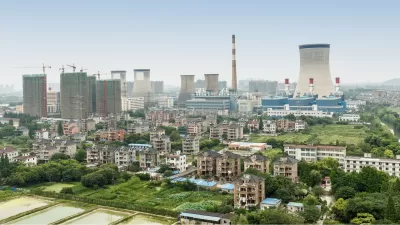In Beijing, the level of air pollution is the highest the monitors at the U.S. embassy have ever recorded since put in place in 2008. The pollution results from a combination of weather conditions and particulate matter - most from coal burning.
Edward Wong reports on the intolerable levels of particulate matter in the air in the Chinese capital on Saturday, Jan. 12. Measured are the finest particles known as PM 2.5 (2.5 microns in diameter or smaller).
"The level of toxicity in the air was 'Beyond Index,' the terminology for levels above 500" because the Chinese system does not report numbers beyond 500. The U.S. Embassy monitors recorded "jaw-dropping reading of 755 at 8 p.m". In N.Y.C., the air quality index measured 19 by comparison. In the Bay Area, a "Spare The Air" alert is issued when levels are expected to exceed 100 - and wood burning is prohibited.
It was unclear exactly what was responsible for the rise in levels of particulate matter, beyond the factors that regularly sully the air here. Factories operating in neighboring Hebei Province ring this city of more than 20 million. The number of cars on Beijing’s streets has been multiplying at an astounding rate. And Beijing sits on a plain flanked by hills and escarpments that can trap pollution on days with little wind.
Chinese officials prefer to publicly release air pollution measurements that give only levels of PM 10, although foreign health and environmental experts say PM 2.5 can be deadlier and more important to track.
On Jan. 14, Wong writes that the level of anger toward the government for allowing the intolerable pollution has resulted in unexpected freedom for the press.
“I’ve never seen such broad Chinese media coverage of air pollution,” said Jeremy Goldkorn, a business consultant in Beijing who tracks the Chinese news media. “From People’s Daily to China Central Television, the story is being covered thoroughly, without trying to put a positive spin on it....the apocalyptic skies above the capital this last weekend seemed to have encouraged an even greater enthusiasm for reporting this story”.
"China Youth Daily, a state-run newspaper, published a scathing signed commentary on Monday ....that questioned basic economic policies and the China growth model: “This choking, dirty and poisonous air forces the Chinese to rethink the widespread, messy development model.”
Bloomberg News reports that according to the head of cardiology at Peking University People’s Hospital, "the number of people coming into our emergency room suffering heart attacks has roughly doubled since Friday".
See Bloomberg video and broadcast, "Beijing Chokes Under a Giant Cloud of Toxic Smog."
Exposure to PM2.5 helped cause a combined 8,572 premature deaths in Beijing, Shanghai, Guangzhou and Xi’an in 2012, and led to economic losses of $1.08 billion, according to estimates given in a study by Greenpeace and Peking University’s School of Public Health published Dec. 18. The burning of coal is the main source of pollution, accounting for 19 percent, while vehicle emissions contribute 6 percent, the report said.
While increased coal burning may partly explain the spike, weather conditions trapping the smog are probably more to blame for the high pollution levels, said David Vance Wagner, a San Francisco-based senior researcher at the International Council on Clean Transportation, a policy consultancy on vehicle- emissions control policy.
Louisa Lim of Nation Public Radio writes that "Beijing is taking emergency action: shutting down some building sites and polluting factories temporarily and taking almost a third of official cars off the road. It's also vowing to cut air pollution by 15 percent over the next three years." Listen to her broadcast on "Beijing's 'Airpocalypse'".
American Public Media's Marketplace covered the air pollution story as well. Listen to broadcast and/or read the interview with Rob Schmitz, Marketplace’s China correspondent, based in Shanghai.
Beijing has moved factories outside the city and tightened vehicle emissions standards, but Zhou Rong of Greenpeace Asia says this time around, the smog is coming from smaller cities outside the capital -- places where local governments have done little to curb pollution in their quest for more economic growth.
FULL STORY: On Scale of 0 to 500, Beijing’s Air Quality Tops ‘Crazy Bad’ at 755

Maui's Vacation Rental Debate Turns Ugly
Verbal attacks, misinformation campaigns and fistfights plague a high-stakes debate to convert thousands of vacation rentals into long-term housing.

Planetizen Federal Action Tracker
A weekly monitor of how Trump’s orders and actions are impacting planners and planning in America.

Chicago’s Ghost Rails
Just beneath the surface of the modern city lie the remnants of its expansive early 20th-century streetcar system.

Bend, Oregon Zoning Reforms Prioritize Small-Scale Housing
The city altered its zoning code to allow multi-family housing and eliminated parking mandates citywide.

Amtrak Cutting Jobs, Funding to High-Speed Rail
The agency plans to cut 10 percent of its workforce and has confirmed it will not fund new high-speed rail projects.

LA Denies Basic Services to Unhoused Residents
The city has repeatedly failed to respond to requests for trash pickup at encampment sites, and eliminated a program that provided mobile showers and toilets.
Urban Design for Planners 1: Software Tools
This six-course series explores essential urban design concepts using open source software and equips planners with the tools they need to participate fully in the urban design process.
Planning for Universal Design
Learn the tools for implementing Universal Design in planning regulations.
planning NEXT
Appalachian Highlands Housing Partners
Mpact (founded as Rail~Volution)
City of Camden Redevelopment Agency
City of Astoria
City of Portland
City of Laramie



























